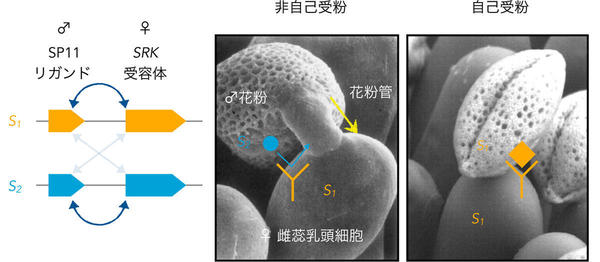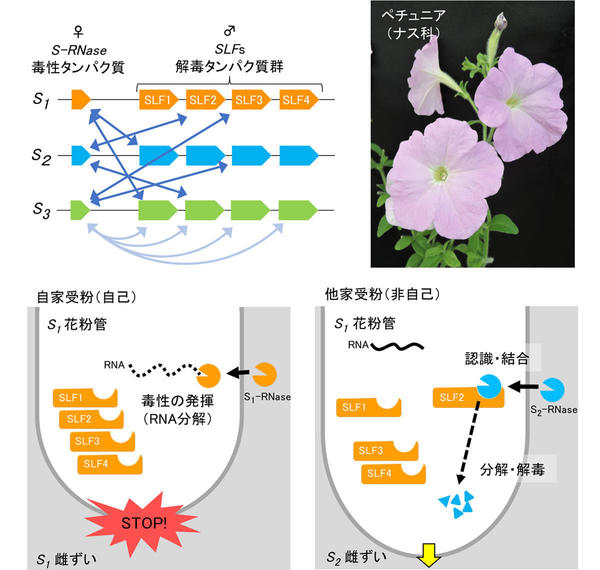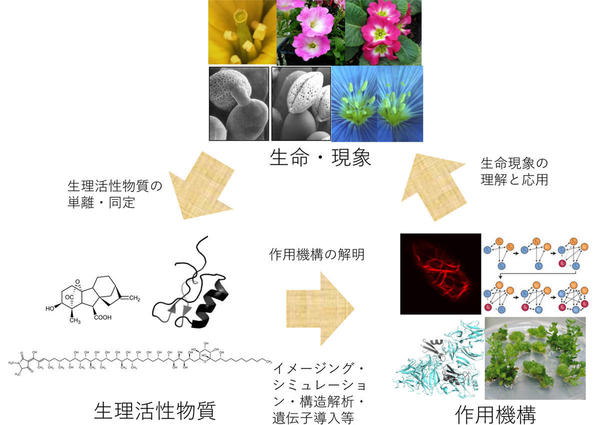植物の自他識別 / Discrimination of self/non-self in plants
私たちが最も力を入れて取り組んでいる生物現象が「植物の自他識別」で、様々な最先端テクノロジーを投入し解明に挑戦しています。
The biological phenomenon that we are working on most intensively is the "discrimination of plants between themselves and other plants," which we are trying to elucidate by applying various cutting-edge technologies.
生殖過程は、植物細胞間のコミュニケーションを研究する上で最適の系です。雌ずいには様々な花粉が運ばれてきますが、交配相手として適切な花粉のみがこの過程で選択されます。適切な花粉は、雌ずい上で吸水・発芽し、花粉管は胚珠まで正確に誘導されていき、そこで受精が行われます。花粉(管)と雌ずいの細胞との間で、実に様々なコミュニケーションが行われていることがわかってきています。我々は、このコミュニケーションの結果を、花粉管のダイナミックな動きとして観察することができます。例えばアブラナ科植物では非自己の花粉が受粉した後、わずか20分程度で雌蕊に花粉菅が侵入する様子が観察できます。
The reproductive process is the best system to study the communication between plant cells. A variety of pollens are delivered to the female nodule, but only the appropriate pollen is selected for mating in this process. The appropriate pollen is absorbed and germinated on the gynoecium, and the pollen tube is guided precisely to the endosperm, where fertilization takes place. It is now known that a great variety of communication takes place between the cells We can observe the results of this communication as the dynamic movement of pollen tubes. For example, in cruciferous plants, we can observe the invasion of pollen tubes into the pistil only 20 minutes after the pollination of non-self pollen.
一方、自己の花粉が付着した場合、拒絶反応が起こり花粉菅の伸長が阻害されます。
On the other hand, when self-pollen is attached, rejection occurs and the elongation of the pollen tube is inhibited.
このように植物は極めてシャープに自己と非自己を識別しています。一般にこのような自他識別は「自家不和合性」と呼ばれています。
In this way, plants distinguish between self and non-self in an extremely sharp manner. In general, this kind of self and non-self discrimination is called "self-incompatibility.
*以上の映像は、NHKEテレ「思考ガチャ!」「身近な人ほど反発してしまうワケ」(初回放送日: 2021年7月9日)で使用されました
私たちはこれまでの研究で、植物の自家不和合性の鍵分子を明らかにしてきました。アブラナ科植物では、雌ずい因子はSRKと呼ばれる受容体型キナーゼで、花粉因子は葯のタペート細胞で作られ花粉表層に移行するSP11と呼ばれる小型のペプチドであることがわかりました。
In our previous studies, we have identified key molecules for plant self-incompatibility. In Brassica, we found that the pistil factor is a receptor-type kinase called SRK, and the pollen factor is a small peptide called SP11, which is produced in the tapetum cells of the anthers and transferred to the pollen surface.
受粉時に、自己の花粉のSP11は、乳頭細胞膜上のSRKと結合し、それを活性化(自己リン酸化)します。このSRKの活性化が引き金となって不和合性反応が起き、自己の花粉の発芽伸長が阻害されるものと考えられています。非自己の花粉のSP11はSRKと結合しないため、不和合性反応は起きず、花粉管は乳頭細胞内へと侵入していくことができます。アブラナ科は「自己認識」によって自他識別を行なっていることを明らかにしてきました。
During pollination, SP11 of self-pollen binds to SRK on the papilla cell membrane and activates it (autophosphorylation). It is thought that the activation of SRK triggers an incompatibility reaction that inhibits the germination and elongation of self-pollen. Since SP11 of non-self pollen does not bind to SRK, the incompatibility reaction does not occur and the pollen tube is able to enter the papillary cell. It has been shown that the Brassicaceae discriminate between self and others through "self-recognition".
一方、ナス科植物の雌ずい因子はS-RNaseと呼ばれるRNA分解酵素であることが古くから知られてきました。雌蕊に大量に含まれるS-RNaseは、自己・非自己の区別なく花粉管の中に取り込まれていきますが、自己の花粉のRNAのみが分解され、花粉管の伸長が停止します。その後、ゲノム解析により花粉因子SLFが同定され、タンパク質のユビキチン化・分解に関わるF-boxタンパク質であることが明らかになりました。そしてSLFがS-RNaseを分解し、花粉はS-RNaseを解毒分解しながら花柱を侵入し胚珠と受精に至ることが示唆されました。
On the other hand, it has long been known that the pistil factor in eggplant plants is an RNA-degrading enzyme called S-RNase. S-RNase, which is found in large amounts in the pistil, is incorporated into the pollen tube without distinguishing between self and non-self, but only the RNA of self pollen is degraded and pollen tube elongation is stopped. Later, genome analysis identified the pollen factor SLF, which is an F-box protein involved in protein ubiquitination and degradation. It was suggested that SLF degrades S-RNase, and pollen penetrates the pollen column while detoxifying and degrading S-RNase, leading to the embryo and fertilization.
私たちグループではさらに、多数のタイプのSLFがひとつの花粉中に存在することを明らかにしました。ナス科では多数のSLFそれぞれが異なるS-RNase分子を分解し、集団の中の非自己全てと受精できるというしくみが形成されていました。すなわちアブラナ科のメカニズムとは全く異なる「非自己認識」システムが採用されていたのです。
Our group also found that there are many types of SLFs in a single pollen. In the Brassicaceae, each of the many SLFs can degrade a different S-RNase molecule and fertilize all of the non-selfs in the population. In other words, a "non-self-recognition" system was adopted, which is completely different from the mechanism in Brassicaceae.
このように地球上で何回も独立に進化した自家不和合性のうち、私たちは二つの分子メカニズムを明らかにしました。植物が以上のような巧妙な仕組みを構築してきたことに驚かされると同時に、原子レベルでどのようにして自他識別が行われているのかが更なる課題です。またこれらのしくみが進化の過程でどのように選択され、洗練されていったのかについても興味が持たれます。当研究室では発見した分子を手がかりに、最先端のゲノム解析・改変技術や、ライブイメージング、構造生物学、計算機シミュレーション等を取り入れた学際的な「生物有機化学」を展開し、生物のミクロとマクロの世界の連結を目指します。これらの研究は新しい生理活性分子の発見、新しい育種法の開発、持続可能な農業生態系の設計につながることが期待されます。
We have identified two molecular mechanisms of self-incompatibility that have evolved independently many times on Earth. It is amazing that plants have developed such sophisticated mechanisms, and it is a further challenge to understand how they discriminate between themselves at the atomic level. We are also interested in how these mechanisms have been selected and refined during evolution. In our laboratory, we are developing interdisciplinary "bioorganic chemistry" that incorporates cutting-edge genome analysis and modification technologies, live imaging, structural biology, and computer simulations, using the discovered molecules as clues.



